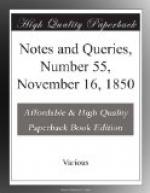I fear that the fact that it was formed of silver and gold, gives little reason to hope that this historical relique escaped destruction when it came into the hands of King Henry’s church robbers. Its sanctity may, indeed, have induced the monks to send it with some other reliques to a place of refuge on the Continent, until the tyranny should be overpast; but there is not any tradition at Durham, that I am aware of, to throw light on the concluding Query of your correspondent P.A.F., as to “what became of the ‘Holy Cross,’ or ‘Black Rood,’ at the dissolution of Durham Priory?”
That the Black Rood of Scotland, and the Cross of Holy Rood House were distinct, there can, I think, be no doubt. The cross mentioned by Aelred is not mentioned as the “Black Rood:” probably it acquired this designation after his time. But Fordoun, in the Scoti-Chronicon, Lord Hailes in his Annals, and other historians, have taken Aelred’s account as referring to the Black Rood of Scotland. Whether it had been brought from Dunfermline to Edinburgh before Edward’s campaign, and remained thenceforth deposited in Holy Rood Abbey, does not appear: but it is probable that a relique to which the sovereigns of Scotland attached so much veneration was kept at the latter place.
W.S.G.
Newcastle-upon-Tyne, Nov. 2. 1850.
* * * * *
REPLIES TO MINOR QUERIES.
Haemony (Vol. ii., p. 88.).—MR. BASHAM will find some account of this plant under the slightly different type of “Hemionion” in Pliny, xxv. 20., xvi. 25., xxvii. 17.:
“Invenit et Teucer eadem aetate Teucrion, quam quidam ‘Hemionion’ vocant, spargentem juncos tenues, folia parva, asperis locis nascentem, austero sapore, nunquam florentem: neque semen gignit. Medetur lienibus ... Narrantque sues qui radicem ejus ederint sine splene inveniri.
“Singultus hemionium sedat.
“‘Asplenon’ sunt qui hemionion vocant foliis trientalibus multis, radice limosa, cavernosa, sicut filicis, candida, hirsuta: nec caulem, nec florem, nec semen habet. Nascitur in petris parietibusque opacis, humidis.”
According to Hardouin’s note, p. 3777., it is the Ceterach of the shops, or rather Citrach; a great favourite of the mules, [Greek: hemionoi], witness Theophrastus, Hist., ix. 19.
Ray found it “on the walls about Bristol, and the stones at St. Vincent’s rock.” He calls it “Spleenwort” and “Miltwaste.” Catalog. Plant. p. 31. Lond. 1677.
I have a copy of Henri du Puy’s “original” Comus, but do not recollect his noticing the plant.
G.M.
Guernsey.
Byron’s Birthplace.—Can any of your correspondents give any information relative to the house in which Lord Byron was born? His biographers state that it was in Holles Street, but do not mention the number.




